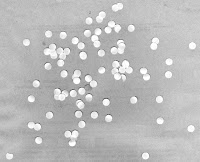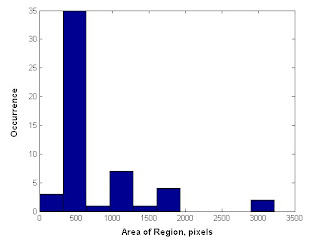Objectives: To apply image processing techniques to the analysis of binary images and to do area measurement on such images
Tools: Scilab with SIP
Procedure:We start with an image of a sheet of paper with holes randomly punched through, simulating cells in a microscope slide for example.

For computing expediency, cut up the image into nine panels of 256 by 256 pixels each. The images are read in grayscale and are binarized individually using im2bw with their own threshold values. This is done since there are areas of the original image which are darker or lighter than the rest of the image. As such each image needs a different threshold for converted to binary. After conversion, the "salt and pepper" noise on the converted images are removed by morphologically closing and opening the image. We have below the 9 binary images concatenated into a composite image:
Using the bwlabel() function in Scilab, we label each individual hole and blob with a distinct integer. Then we use the find function to search for each of these values. We sum up all the values to find the area of each blob. Below, we have a histogram showing the number of occurences of a range of areas. We see that the most common areas are the small values corresponding to individual holes.

Evaluation: Since the results correlate closely with what is expected, a grade of 10 is proper.
Acknowledgements: I would like to thank Mr. Neil Cabello for his invaluable assistance.

Must show what the expected value should be.
ReplyDelete